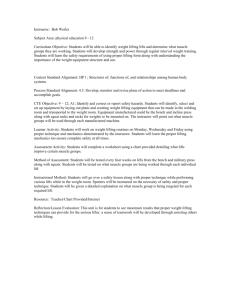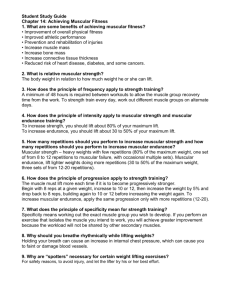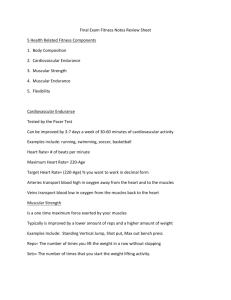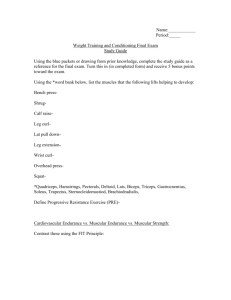Weight Training Study Guide
advertisement
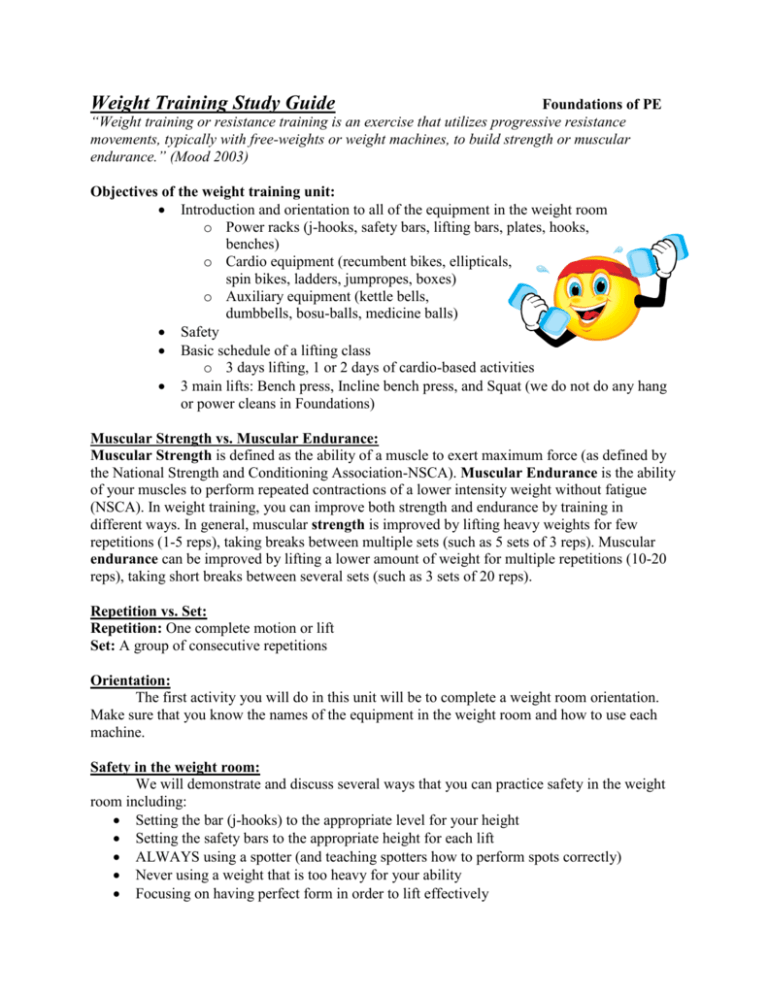
Weight Training Study Guide Foundations of PE “Weight training or resistance training is an exercise that utilizes progressive resistance movements, typically with free-weights or weight machines, to build strength or muscular endurance.” (Mood 2003) Objectives of the weight training unit: Introduction and orientation to all of the equipment in the weight room o Power racks (j-hooks, safety bars, lifting bars, plates, hooks, benches) o Cardio equipment (recumbent bikes, ellipticals, spin bikes, ladders, jumpropes, boxes) o Auxiliary equipment (kettle bells, dumbbells, bosu-balls, medicine balls) Safety Basic schedule of a lifting class o 3 days lifting, 1 or 2 days of cardio-based activities 3 main lifts: Bench press, Incline bench press, and Squat (we do not do any hang or power cleans in Foundations) Muscular Strength vs. Muscular Endurance: Muscular Strength is defined as the ability of a muscle to exert maximum force (as defined by the National Strength and Conditioning Association-NSCA). Muscular Endurance is the ability of your muscles to perform repeated contractions of a lower intensity weight without fatigue (NSCA). In weight training, you can improve both strength and endurance by training in different ways. In general, muscular strength is improved by lifting heavy weights for few repetitions (1-5 reps), taking breaks between multiple sets (such as 5 sets of 3 reps). Muscular endurance can be improved by lifting a lower amount of weight for multiple repetitions (10-20 reps), taking short breaks between several sets (such as 3 sets of 20 reps). Repetition vs. Set: Repetition: One complete motion or lift Set: A group of consecutive repetitions Orientation: The first activity you will do in this unit will be to complete a weight room orientation. Make sure that you know the names of the equipment in the weight room and how to use each machine. Safety in the weight room: We will demonstrate and discuss several ways that you can practice safety in the weight room including: Setting the bar (j-hooks) to the appropriate level for your height Setting the safety bars to the appropriate height for each lift ALWAYS using a spotter (and teaching spotters how to perform spots correctly) Never using a weight that is too heavy for your ability Focusing on having perfect form in order to lift effectively Warming up properly and stretching afterwards Cleaning up and keeping the area(s) clear to avoid accidental injury Take a day of rest between major lifts to avoid injury: for example, do not perform bench press 2 days in a row. Allowing your muscle fibers to heal is actually what makes them stronger. Lifting Technique(s): For each of the main lifts that we teach in Foundations, we will demonstrate and discuss technique. You will be responsible for knowing and demonstrating proper lifting form for each. 1. Bench Press: Back is flat on the floor Feet are flat on the floor (adjust the bench so this is possible) When grabbing the bar the thumb is wrapped around the bar, equal distance on both side (use the knurling rings to ensure proper form) Hands should be at least shoulder Bring the bar down to chest, just above nipple height Inhale on the way down, exhale as you exert force and perform the lift 2. Incline Bench Press: Refer to all techniques for standard bench press plus o Adjust bench to 45 degrees o Adjust length of bench to accommodate your height 3. Squat: Place feet shoulder width apart or slightly wider Athletic stance (toes slightly out) Bar rests on the fleshy part of your back, not your neck: shoulders are back and chest is UP or big Shift your weight back and down, bending knees to 90 degrees Weight should be on your heels and knees should not come in front of your toes References: Sports and Recreational Activities: Mood, Musker, and Rink. McGraw Hill, 2003 www.livestrong.com

